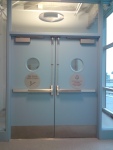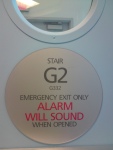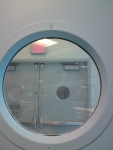Filed under: Uncategorized
A simple story happened in Simon Fraser University Surrey on February 20, 2009 at around 12:30pm. It was a warm and sunny afternoon; I was sitting in front of the big glass window at the end of the long corridor on the 3rd floor of the campus.
As I was eating my lunch, I casually looked out the window and I sensed some movement out of the corner of my eyes. I looked to the left and saw a student in the opposite building connected to the campus. His eyes brightened when he met my gaze. He waved and pointed at the door. A partial of the building wall was made of glass which allowed me to see the three fire doors that trapped him. I acknowledged his need, and walked to the doors. When I reached them, there was a sign with red words that said Alarm will sound when opened. I hesitated and went back to the glass window. I waved at the person and tried to mouth: I cannot open the door. He obviously could not understand what I was trying to tell him. We have silent conversation for a few seconds and none of us understand each other. He made a gesture of No, and I copied him. His shoulders seemed to slump and I sat down again.
Although I stopped helping him, I kept my eyes on him. I saw he walked up to the fourth and fifth floor. He stopped on both floors for some minutes and tried to get people’s attention. He was ignored. Eventually, he wandered back to the 3rd floor, and waved at me again. He pointed at the doors and I shook my head. I made a gesture of using the phone, but he shook his head and gestured something like “no batteries”. I pointed down meaning I am going downstairs, and I mouthed: I will go get help, but I was pretty sure he didn’t know what I was doing. I went to the security desk and told the securities what was happening. They told me that a person cannot possibly be trapped in there. I asked about the alarm of the fire door and they seemed to ignore the question. They simply told me to tell him to “go back”, and he would be able to get out. I ran back up and told him to go back, by mouthing the words and pointing at the direction of his back. He turned around and anxiously looked. He mouthed something; I guessed it was “There are no doors”. I ran back down but got no useful answers back.
There were no signals.
I ended the call and so did he. Then he pointed at me. I understood and started gesturing my phone numbers. I could sense people passing by staring at my somewhat awkward performance.My finger jumped to the talk button the moment my phone started ringing.
“Hello?”
“Hello?”
We said at the same time. I paused and he started talking non-stop on how he got behind the three doors.
“I got lost and I went through the fire doors. I got through them all. Go open them, it won’t sound. Trust me.” He instructed.
“It won’t sound. Trust me.” He said again.
Nothing happened.
I opened the other two doors, and he finally got out. He thanked me twice and we said goodbyes. Then he walked down the corridor and I sat back down in front of the glass window.
I continued my lunch and felt accomplished. Yet, I thought maybe it would only take seconds if I was brave enough to open the doors in the first place.
Filed under: Uncategorized
By Yen Lin, Lulu Huang, Connie Lee, and Jessica Cheng
Part I: Communication in everyday life Tell me about the different ways that you used communication for 24 hours in your journal.
Connie: I used mostly MSN as my daily communication technology. The other medium I use are e-mail and cell phone. I also use Google to do researches that helps gain my knowledge of the world.
Jessica: I used many forms of communication in the span of 24 hours, though some overlapped. Twitter, email and MSN chat are three different platforms I used to communicate in the same manner: using text. Internet browsing may also be included, as I frequent some online forums and post messages as well. The exception was when I used my cell phone to communicate using speech.
Lulu: MSN is the most daily communication medium. And other technology I used is Facebook and BBS, to contact my friends and chat with them. I also used iPHONE to call.
Yen: I use cell phone, MSN, Facebook for socialization with my friend, email and WebCT for school use, and Google and television to help me to be more familiar with the world and what I am interested.
2. What was the most common communication media that you used in 24 hours?
Connie: MSN is the most common communication media.
Jessica: Twitter and forum posting were both the most common media I used in 24 hours.
Lulu: MSN. When I woke up, the first thing was to log in MSN, and I log out until I went to sleep.
Yen: MSN
3. What was the most common purpose for the communication media you used?
Connie: The most common purpose for the communication media I used is to chat with people and to have instant conversation with long distance friends.
Jessica: I mainly use Twitter to chat with online friends, as I am not usually logged in onto instant messaging services such as MSN Live. As for my posts on forums, I usually discuss things relevant to my interests. Both of these media allow for the user to communicate with others, though Twitter is considerably more faster-paced, whereas I would be more likely to put more thought in my forum posts and be more articulate due to the lack of a restrictive character limit.
Lulu: The most common purpose for the communication media I used is to contact my friends more convenient even for the friends in other countries.
Yen: The most common purpose for the communication media I used was socialization with friends.
4. What do you think you learned most about the role of communication media in your everyday life by keeping this journal?
Connie: By keeping this journal, I learned that I have more ‘MSN talk’ than the actual face-to-face communication with others.
Jessica: I learned that I spend quite a lot of time online, whether for schoolwork or for leisure. The day I recorded my media-related activities was actually a somewhat busier day for me – other days, I would check Twitter and forums at regular intervals every few hours to check for responses to my messages or interesting materials to reply to.
Lulu: Through this journal I found the communication mediums I used are all should get on internet, as MSN, Email, BBS, and Facebook.
Yen: MSN plays an extremely heavy role in my life. I use it to keep contact with my friends. MSN is my dominant communication media for socialization.
5. What was the most surprising thing that you learned from keeping this journal?
Connie: It was surprising that the technology I enjoy to use the most, which is YouTube, is one of the technologies that I used the least time.
Jessica: The most surprising thing was the amount of time I spent browsing the Internet compared to other media.
Lulu: From keeping this journal, the most surprising thing for me is that if there is no internet in this world, the only way I can communicate with my friends is phone, which is very expensive if I call the long distance friends.
Yen: I spent more than one-third of the day on MSN. It actually steals my time so that I often feel there is always not enough time for me to do my work. Since MSN is my dominant communication media, it will be difficult to keep in touch with my friends without it
6. What are some of the positive implications about having communication media in your life?
Connie: The greatest advantage I got from using the media, the internet, is that I am able to keep in touch with the world anytime I want. I can chat with my friends, read and watch news, find entertainment and do research on assignments just by simply clicking on the mouse.
Jessica: The main positive implication about communication media’s presence in my life is the mere fact that I can communicate with other people online – some of whom I would’ve never met nor talked to otherwise. It also allows me to experience material which would be inaccessible to me. For example, I frequently use a video site named “Nico Nico Douga”, which is basically the Japanese equivalent of Youtube – with the unique distinction of that it has a pseudo-real time element in its’ commenting system. Comments scroll across the screen as the video plays and gives the very real impression that you are watching with other people, rather than having to scroll downwards and away from the video. Also, with the advent of Google, information is easily accessed, compared to a library, which may have a limited number of resources dealing with particular subjects.
Lulu: I only need to pay the internet fee for any of my communication mediums, even for long distance communications.
Yen: I can easily keep in touch with friends all over the place and connect with the world and follow course schedule.
7. What are some of the negative implications about having communication media in your life?
Connie: One of the greatest disadvantages using the media is that once I started searching through the internet, it takes up a lot of time because there is just so much interesting information. If I am not able to pull myself out, I would be spending too much time using the computer. Also, I rely heavily on the internet since it is very quick and convenience to search for information online. This causes me to slowly lose the ability to look for actual materials that are also available in other places such as the library.
Jessica: Several negative implications I can think of: First, the somewhat addictive nature to communication media. With so much to do and participate in, it’s not difficult at all to suddenly find yourself having spent hours just surfing and chatting online and not having gotten any work done. Second, the ease of using resources such as Google and Wikipedia has mostly taken over my preference of browsing the library as a first priority for looking for information – although I still would choose reading printed material over reading long documents on a screen. Third, without any visual cues such as emoticons, it’s hard to tell emotions through text. While chatting, one can interpret words in their own different ways.
Lulu: If I cannot get online, I can use none of these mediums.
Yen: I spend too much time for unnecessary socialization. Also, I use several media together so that it’s hard for me to focus on one assignment at the time.
8. How do you think your life would be if you did not have access to communication media; please talk about both the positive and the negative things that might happen.
Connie: I believe my life will be rather miserable because without the internet, I would have to do a lot of things on my own such as hand writing, and researching, which would also cost a lot of time during the process. Yet, I believe I would be more active and healthy because without the internet, I would have to go out and look for information and also have actual socializing with others.
Jessica: Without communication media, I definitely wouldn’t have experienced certain things – such as liking music of a certain genre, since it’s not the kind that the radio stations here would air. However, a negative aspect is the sheer amount of addicting, yet practically useless content available, made only for entertainment.
Lulu: If I did not have access to communication medias, I would have less friends, and had no contact with my long distance friends. I would cost a lot of money on books. So I would spend more time on reading books to enlarge my knowledge.
Yen: Without communication media, it might help me to pay more attention on the actual content of one material at time and less disturbed. However, without communication media, it is hard to socialize to friends and family who are not in the same town or living area.
9. If you had to choose one communication media to take on a desert island, which one would you choose and why?
Connie: If I am allowed to bring a communication media with me to a deserted island, I would bring the MSN. This is because although I cannot talk to people face -to-face, the instant messages I sent out and received provide me the feeling that I am talking to an actual person.
Jessica: If I could choose only one form of communication media to take with me, it would probably be email due to its’ relatively small file size (compared to sound or video files) and its’ widespread use.
Lulu: I would choose MSN to go with me if I had to bring a communication media on the desert island because it is the most frequently communication media that I used. And I can find almost all my friends on it. It is very convenience for me.
Yen: If I can only choose one communication media to take to a desert island, I would choose a cell phone for its multiple functions. A cell phone today includes most of the communication media such as msn, surfing the net and still has its most dominant function which is to make a phone call when it is needed.
Part II: A world without communication media Mission: to Arrange for invited speaker from Beijing, China to lecture at the First Annual Technology in Context conference The communication media we listed in part one is: MSN, email, Facebook, Twitter, cell phone, WebCT, Google, and television. Since we are not allowed to use these media to communicate, we listed out the following media to contact and plan for our guest speaker: – Mailing – Skype – Drop in appointment with an travel agent – Fax We first mail the speaker a formal invitation about the lecture, and ask them to reply with their fax number and Skype for detail discussion. Later, we use Skype to talk to the lecturer about the details of the event and special needs during the trip (such as hotel and food). Then, we go to the travel agents to book flights, hotels, restaurants and etc for the guest. After planning, we fax the speech materials and detail about the trip to the speaker. Finally, we send a formal confirmation by mailing. Timeline Medium Time Duration Context Expense Mailing Beginning of February 2 – 4 weeks to process Formal Invitation Approx. 1.70 CAD Skype Beginning of March One Day Talking through Skype phone about event’s details 12.95 CAD/month Travel Agent (Personal meeting) Mid March One Day Booking of flights, hotels, food, transportations etc. Include in the travel package Fax Mid March Several Minutes Speech materials and details about the trip 24.95 CAD/ month Mailing End of March 2 – 4weeks to process Formal Confirmation 1.70 CAD Questions 1. What were the most difficult parts of the mission? We are all accustomed to the advanced technologies that we have nowadays, when we first started the project, we had some troubles even on how to contact the speaker who we over sea. We listed out the device options we had, and most of them were not allowed to use. We then considered the more traditional technology which are post mailing and faxing. Although it was more time consuming and require more effort, we found that they were one of the only ways we could use under the limited choices, and they were also more formal and appropriate for the situation. 2. Which communication media would be most missed in the world and why? The communication media most missed is email, which all of our group members included in their journal. Email is quick, convenient, and widely used. It would be a major time-saver in cases like these, in which we could just send the same invitation email to all five speakers at once without having to either use regular mail (which would take some time considering all of the speakers are located overseas) or fax (cannot easily send one message to multiple people at the same time). 3. What are the expenses for the planning and coordination of this conference? (you do not need to worry about venue expenses, food, or any other details aside from the planning requirements listed above). The expense for the planning can be referred to the table. We use mail, Fax, Skype, and travel agent to plan our event with a speaker from China. Therefore, the duration of preparation is approximate 2 months before the lecture. We first spend 1.70 CAD for mailing an invitation to the speaker from Vancouver to abroad, and later, fax a message to the speaker and ask the speaker’s Skype. The price of the fax is including in our monthly package of a phone number, twenty five dollars per month. We spend 50 dollars for faxing material about the lecture to the speaker in total. Also, to speak to the lecturer on Skype, we need to pay 12.95 dollars per months for its call service. We pick an afternoon to meet a travel agent in person for planning and booking the speaker’s flight, hotel, and car rental. Here, the cost of speaking to an agent is including in the lecture’s trip. Last we sent another confirmation letter and the detail of the lecturer’s trip by fax and mail. We send two letters (1.70 X 2), buy the monthly pack for Skype and phone plan (12.95 X 2 + 25X 2). In total, we spend 88.82 dollars (including tax) for contacting and event planning purpose. Talk in international Asia pacific plan. Retrieved from http://www.rogers.com/web/content/home-rogers/tiap Pay Monthly. Retrieved from http://www.skype.com/allfeatures/subscriptions/#mexicanSubscriptionTab Price of international mailing. Retrieved from http://www.canadapost.ca/cpo/mc/languageswitcher.jsf
Filed under: Uncategorized
TechPost #1
Connie Lee 301112513
technology: Kangen Water Machine
-Kangen Water Machine is produced by a revolutionary Japanese water technology that turns human’s acidic, contaminated and chlorinated tap water into healthier alkaline water. The alkaline water neutralizes free radicals and helps maintain and improve one’s health. Free radicals are the unstable oxygen atoms that cause oxidation in one’s body, which brings about the aging and weakening process. An increase in free radicals can be caused by things such as pollution and contaminated food and water.
Maintaining stable oxygen atoms in our body helps to reduce oxidation. For optimal health, the cells in one’s body needs to stay at their natural alkaline balance. However, the pH levels are often disrupted by dehydration, stress, and the acidic processed and refined food we eat. Very often, an overly acidic body is the root of many common diseases, such as obesity, osteoporosis, diabetes, and high blood-pressure.
In the article The Greeting of ….Your Body! written by Denis Ouellette, the Optimal Breathing Development Specialist and editor of Natural Life News & Directory, explains that the word Kangen in Japanese means back to the origin. The Kangen Water Machine allows users to choose the pH level of the water to be made. It has a rage of pH level of 2.5-9.5. The Kangen water system filters the water first, and then passes the water over a series of electrode plates. The electrical force magnetically polarizes the water based on the pH charge of the minerals in the water. Alkaline water comes out one outlet, while acid water (2.5) comes out another. Acid water can be used to disinfect topically on the skin and hair, for sanitizing, and for watering plants. Alkaline water (8.5-9.5) is for drinking, which helps restore user’s body to a healthy alkaline state.
One of the advantages in producing alkaline water with the Kagen Water Machine is that it is quick, safe and reliable. The water alkalizing and ionizing devices have undergone 35 years of development, testing and using in hospitals in Japan. With the low-pH acid water, Japanese doctors were treating skin conditions such as psoriasis, bed sores and diabetic ulcers. It is qualified for effectively slowing down the aging process, increasing absorption of important vitamins and minerals, and most importantly boosting the body’s immunity against diseases.
In a book The Hidden Truth of Cancer, written by Dr. Keiichi Morishita, states that cancer cells tend to develop in a more acidic condition. Drinking water that has a high alkaline pH, because of its de-acidifying effect, will help in preventing cancer. Morishita also explained that the lacking element that normal drinking water is not able to provide. The water molecules in our body do not individually float around; they exist in clusters of water molecules. The alkaline water clusters are significantly smaller than normal the water clusters. Normal water clusters consist of about a dozen water molecules. Because the clusters are so big, that they cannot penetrate many places in the body. By making clusters half that size, the clusters can penetrate into more places in the body. The hexagon shaped alkaline water clusters also help them get into places regular water cannot go.
The Kangen water machine obviously brings a positive contribution toward humans’ health. According to the statistics of Enagic Water Company, more than 200 water machines are sold each month in Canada and more than ten thousand people benefits from the alkaline water. In terms of the society, it helps lighten the burden of the hospital budgets. With the help of maintain health by simply drinking alkaline water, the health care department has reduced stress on the expenses that support the operation of the hospitals. Although the Kangen water has significant benefits in improving and maintain one’s health, one should not only rely on drinking water; exercising regularly and having a balanced diet and positive attitude are also great ways for keeping in good shape.
References
-Ouellette, D. (2008).The Greeting of ….Your Body! Retrieved February 7, 2010,from
http://www.integralbreathwork.com/pdf/GreeningBody-All.pdf
-Morishita , K. (2009). Hidden Truth of Cancer. Retrieved February 9, 2010 from
http://www.google.ca/#hl=en&source=hp&q=The+Hidden+Truth+of+Cancer&meta=
q=f&oq=The+Hidden+Truth+of+Cancer&fp=e2ba582240fd653a
-kangencanada.com. Retrieved February 8, 2010. From




